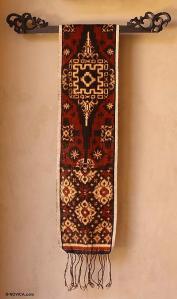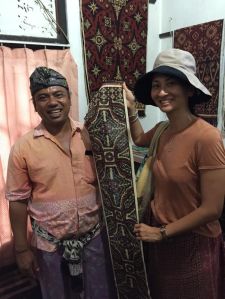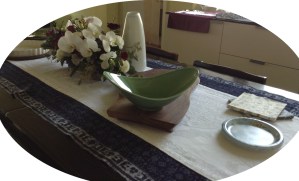As Sabine, my co-author (and her daughter Natasha) will tell you, I have been meaning to write this blog but got caught up in the post-summer, back-to-reality scrambling around of life after a long holiday. Sitting down at my computer, I read “So, your style is…Peruvian?” on our blog and was prompted to pen my brewing thoughts which segway so nicely to our guest contributor Alexia’s ideas.
Alexia says that for a Peruvian, a home would have all the comforts of beautiful tapestries, embroidered pillows, and other soft furnishing bursting with color. I would argue that this isn’t just unique to Peruvians! Comfort in the home interior and not being “afraid to use color” are true for most cultures and should serve as an guiding principle for all interior designers regardless of design style.
In today’s modern or contemporary design ethos, we are cocooned in neutrals with a shot of highlighting color to add character. Do any of us actually live in this way? Very few people possess a completely blank slate for an interior designer to fill. Nowadays, we are all global citizens either because of the reach of multimedia, travel and the old-fashioned conduit -books. Whether we like it or not, we collect over our lifetimes, either very basic family photos or Vietnamese paintings bought on a trip to Hanoi or those silver bowls or that Buddha head acquired in Chinatown in New York City or Haight Street in San Francisco.
We collect because we form a mental and emotional connection with people, places and ideas. We also acquire or inherit things important to our family or culture. Those connections should always be showcased in your home.
One of my personal connection is with ikat. On a recent holiday to Bali, I was inspired again in my own interior design by the intricate yet widely diverse indigenous ikat that defines the heritage of Bali as well as the other islands of the Indonesian archipelago. In my 20s, I lived and travelled extensively in Indonesia and that is where I learnt about the art of ikat – how traditional techniques were dying because they were too time consuming and how modern Indonesian designers like Bin House, Bijan and others were trying to keep the tradition alive by using ikat cloth in woman’s fashion. I had flashbacks of Indonesian weddings and other formal events where the most sumptuous silk ikat sarongs, worn with a kebaya blouse and a draped stole over the shoulder, are the Indonesian equivalent of the evening gown. The effect is truly dazzling!
However, in recent years, I haven’t thought about using ikat in decorating or in dress. While in Bali, I was seduced again by ikat which was subtly pervasive. You see it in the uniforms of hotel staff, decorative hanging pieces in restaurants, ceremonial dress and the everyday sarongs/shirts of the Balinese. I found myself spurning the ikat sarongs massed produced and sold on the beach to tourists because I remembered all I learnt about ikat. This connection – forged from living in Indonesia, from the memories of friends in the Indonesian fashion industry who taught me about ikat and from the undeniable beauty of the art of ikat – got me thinking about living with it again in interiors.
In my desire to embrace ikat and show my family the Bali from 20 years ago before the boom in development, I arranged a day trip to visit Tenganan Village, one of the oldest Balinese villages in East Bali. Although it has welcomed increasing numbers of tourists over the past few years, Tenganan remains a traditional Bali Aga Hindu village in its everyday life. Enroute, I felt the old Bali in the untouched mountains and rice paddy fields which had inspired the impressionist paintings of Arie Smit and his generation of artists. I tried pointing out the lulling landscape to my daughter who, in her typical no nonsense way, spurned my attempt as a tour guide for her Kindle. So much for trying to pass on a forgotten time!
In Tenganan, we visited a weaver’s home. Even though I had already done my Internet research, I couldn’t believe that our guide was Pak Nengah Dika who was also mentioned in “Tenganan: home of Bali’s rarest textiles” by Geoff Vivian on the website inBali!
After entering the outer compound to the interior of his house, I saw only one loom and a half-completed gerinsing. Hung around the room were many other simpler woven cloth and ikat pieces including sarongs. (As an aside, from an interior design standpoint, raised concrete platforms, almost like bales within that one room, delineated different functional areas.- the antithesis to the sunken living room!)
These simple pieces weren’t what I was seeking but I did not wish to offend so I perused leisurely. After half an hour, his wife Li Nuh Suryati clued in and offered to show me her stock of prized gerinsing. Pak Nengah and Ibu Li had a separate tiled room in the back with glass storage cases holding folded stacks of gerinsing. As they pulled out piece after amazing piece to show me, there was no denying the beauty and skill of Ibu Li’s work.
Tenganan is the only place in Indonesia that makes gerinsing, double ikat which requires that both the warp and weft yarns are tied and dyed before being woven. Translated for us lay folk, both horizontal and vertical threads are treated in the same manner. All the dyes are natural and I was asked to not only notice the yellow, red and darkish reddish brown but also smell the earthy pieces to verify. This painstaking handmade process makes gerinsing difficult and time consuming to produce, with the finer the motif, the better the weaver’s eyesight and skill.
Geringsing itself is attributed with magical qualities of protection so they are used by the weaver’s family in ceremonies marking the movement from one life stage to another – a child’s first haircut, coming of age in joining the youth association, marriage, etc. In addition, geringsing is rare because it is a closely guarded tradition passed from mother to daughter.
At first the selection was dizzing but after some time, I started recognizing a number of repeated motifs as kindly pointed out by Pak Nengah – the cemplong frangiapani flower, the symbol for the village itself and the most revered Wayan shadow puppet, among others. I ended up buying two beautiful pieces which I know can somehow be incorporated into my home decor. I chose the darkest reddish brown pieces which framed against a rough silk backing would fit into any decor easily. For a more rustic feel, one could always use the carved display rod which came with my pieces.

Lubeng cemplong geringsen with wooden carved hangar (from http://www.novica.com)
Separately on this trip, I had also come across some dark blue ikat pillows sold by Threads of Life which would also fit into most decors easily. I already own a beautiful indigo piece (dark blue is the hardest color to achieve as it requires repeated dying) which when set against a white French cotton tablecloth would make for an elegant Christmas dining table. (Threads of Life is a fair trade businesses seeking to keep alive the ikat tradition. If you are ever in Bali, they have various Indonesian textiles classes one could join).
Ikat is living art that goes beyond the craft of dying and weaving cloth. While used in everyday life, it is highly symbolic and an expression of the weaver’s values, culture and life. I believe that this makes it no different than a painting or sculpture
What is your inspiration?
Katherine





Pingback: Upcycling for Your Holiday Decor | KaSa Global Interiors·
I just saw this “on trend” article on houzz.co.nz this morning. It shows in the many different ways ikat patterns are used in interiors today. Quite interesting! http://www.houzz.co.nz/ideabooks/51357792?utm_source=Houzz&utm_campaign=u3713&utm_medium=email&utm_content=gallery1
LikeLike
This waas a lovely blog post
LikeLike